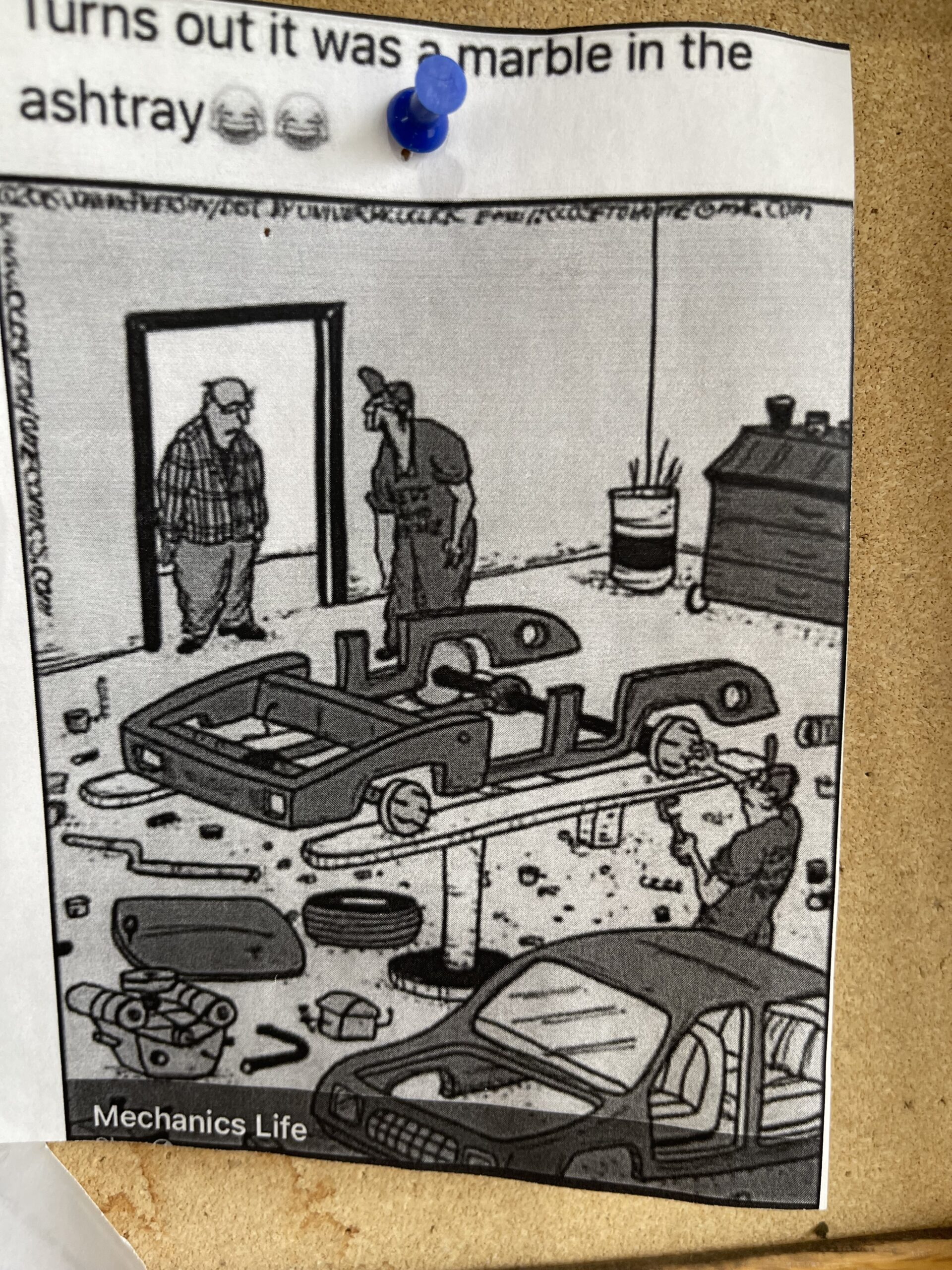Last Friday was drizzly, the kind where the rain isn’t sure of itself. I went for my pickup truck’s annual inspection.
In the corner of that musty garage, mechanics’ hands as greasy as the floor, there was the usual bulletin board; an artifact with layers of oil change reminders and lost dog flyers.
 Among this community collage, a cartoon—its grays and blacks fighting through layers of dust—snagged my attention. A car laid out like a jigsaw puzzle gone wrong, parts scattered with careless abandon. Two mechanics presiding over this metallic chaos definitively explaining the source of the problem to the customer: “Turns out it was a marble in the ashtray.”
Among this community collage, a cartoon—its grays and blacks fighting through layers of dust—snagged my attention. A car laid out like a jigsaw puzzle gone wrong, parts scattered with careless abandon. Two mechanics presiding over this metallic chaos definitively explaining the source of the problem to the customer: “Turns out it was a marble in the ashtray.”
We fundraisers aren’t much different than those mechanics. Minus oil-stained coveralls, we dig around the engines of our operations in search of sources of problems and seek solutions.
But here’s the thing: in the buzz of new technologies, the brave new worlds of behavioral science and AI, we risk missing the simple stuff. The marble in the ashtray.
You see, nearly a third of all donors walk out the door, not because we didn’t have the shiniest tools or the latest data-crunching gizmos. They exit because we forgot the prompt and heart-felt thank you note. All they may have needed to stick around was to hear they mattered. That’s the marble—right there in the ashtray. [See Is Gratitude a Top Priority for Your Organization ]
Take our mailing lists, for instance. Did you know a nonprofit with even a below-average bad address rate of 1% and, let’s say with 25,000 donors, can bleed over $150,000 in five years if addresses are left to gather dust. This is the most basic of basics—keeping names and addresses current, avoiding the clutter, expense and embarrassment of the outdated. [ See Two Low/No Cost Tips to Boost Year-End Revenue ]
And when the sad news comes that a donor has died how quickly do we act? Although only 1% of the attrition rate in the commercial world is attributable to death it’s quite different when it comes to nonprofit retention. In our sector we lose 16% of our donors lose to mortality. We’re not good at doing even simple things about deceased donors.
Most organizations don’t do anything proactive to Identify or be alerted to our loyal, now lost supporters. We don’t’ stop the mail that’ll only serve as a blunt reminder to those left behind. Nor do most both to reach out with the human touch of condolences and respect to donors’ spouses or families. Failure to address the issue of deaths of our donors with proper procedures and grace is more than an oversight—it’s a breach of the unspoken covenant we hold with those who trusted us. [ See The Case of the Disappearing Donors ]
Now, let’s talk about relationships. You ever get the feeling you’re the only one talking at a party? That’s us, too often. The Agitator’s been harping on feedback for years. Few seem to heed our plea. It’s not just good manners; it’s good business. Feedback’s a handshake, a pat on the back, a two-way street that’s one of the least costly ways to keep our donors close. Mail, website, email, social media—you can seek everywhere. It’s mighty important when it comes to retaining donors. [ See Kevin’s series on the three levels of feedback: here,here and here.
And then there’s knowing what to measure. You don’t need a fancy gadget or high paid analyst for this. Retention rate and lifetime value are basic measures—the GPS of fundraising . They’re vital signs, not noise such as “likes” or “clicks” or the digital chatter that we sometimes mistake for meaningful feedback and guidance. We live in a landscape where the fundamental is in danger of becoming obscured by the unnecessary. [ See Fundraising Metrics That Matter ]
It’s time to get back to basics. It’s time to look for the marble in the ashtray. Before we tear the engine apart, let’s make sure we’re not just chasing after that rattle with a toolbox full of fancy, forgetting the essentials.
Remember the Marble.
Roger













